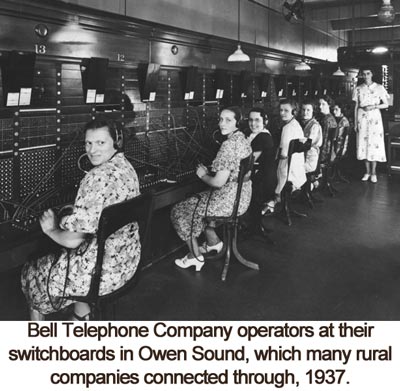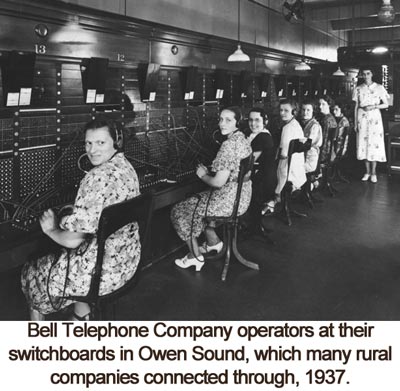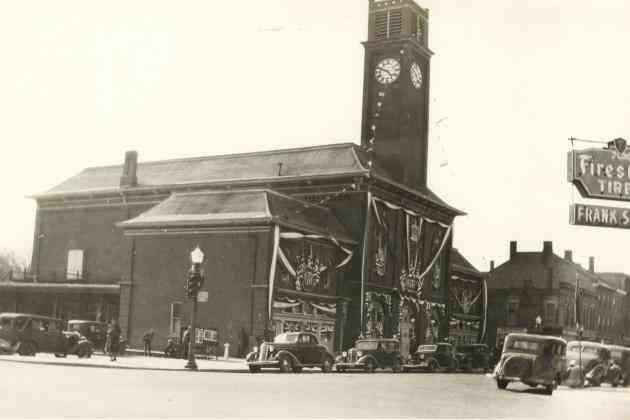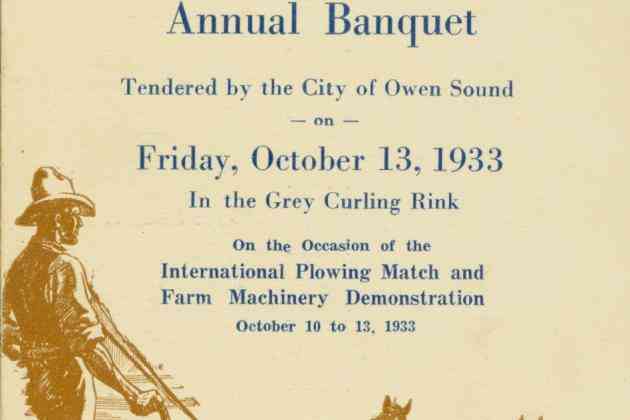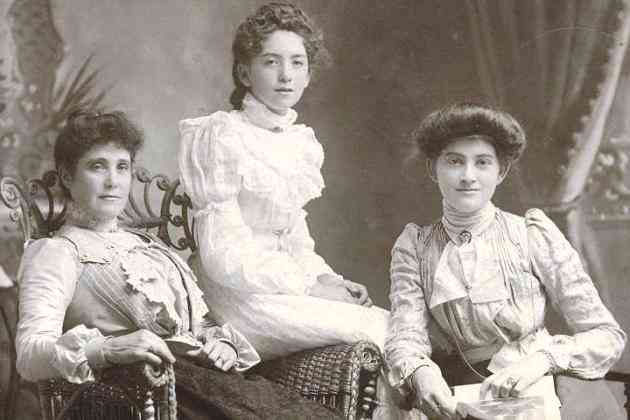Rural Telephone Companies in Grey
In the early years of the telephone industry, there were many small local companies that sprang up to accommodate the desire of rural residents to be connected by telephone. Although Bell Telephone Company of Canada had a strong presence in the Grey County area—arriving in Owen Sound in 1884, four years after the company’s inception—telephone coverage mostly remained in larger cities since it was not considered profitable to service the outlying regions of these towns.
Started out of community initiative, many independent telephone companies began to appear, with rural residents forming clubs to look into the possibility of providing telephone service to their areas. When these businesses finally formed, club members became the owners, staff, and shareholders of their companies. Glad to aid these independent groups in their fledgling state, Bell Telephone Co. would offer yearly inspection services to help advise non-competing independent companies on areas of improvement in their equipment and service. These small companies were not an autonomous service, but rather connected through the switchboards of larger companies like Bell Telephone Co. in order to operate. Signing connection agreements with both Bell Telephone Co. and other nearby telephone companies to link services across regions, these rural lines became connected to a vast network of companies working to provide quality telephone service across Ontario.
The Glen Eden Telephone Club and Balaclava Telephone Club made an agreement in 1912 to share their intended telephone lines throughout a portion of their service area, and eventually would share this line with Leith and Annan Telephone Company as well. Glen Eden Telephone Co. signed a contract with Bell Telephone Co. in the same year, connecting to the established Owen Sound lines, and by doing so, launched a nearly fifty year business. The company was run by the subscribers of the line—even its two linesman were subscribers—a truly locally run affair. Despite strong beginnings, by 1949 service was deteriorating badly each year as it became difficult to support and maintain the lines. Leith and Annan Telephone Co. gifted their share of the line to Glen Eden Telephone Co. in 1954, and Balaclava Telephone Co. would end their shared agreement within the same year. By 1959, Glen Eden Telephone Co., Balaclava Telephone Co., and Bognor Telephone Co. had all declared their intent to dissolve their companies at the same time, with Bell Telephone Co. to take over their service areas, something which was a regular pattern for rural telephone companies upon their collapse.
The Peabody Telephone Association with its headquarters in Chesley formed in 1914, eventually becoming Victory Telephone Co., bringing telephone service to rural residents on the edge of Sullivan Township. Signing contracts with Bell Telephone Co., Bond Telephone Co., and Scone Telephone Co., they were in business until 1965, having also acquired the assets of Desboro Telephone Co. upon its dissolution in 1959. Like Desboro Telephone Co., their service had become either unsustainable or obsolete, and in January of 1965, Victory Telephone Co. completed negotiations in order for their defunct lines to be incorporated and maintained by Bell Telephone Co., ending operations after fifty years of service to Sullivan residents.
The Centre Road Telephone Co. was one of over forty-five independent companies in Grey County listed in the 1917 Telephone Act. The Centre Road Telephone Club of Woodford had formed into an official business in 1915, signing a contract with Bell Telephone Co. in the same year to connect through their Owen Sound lines. Sharing the area with their services were Woodford Telephone Co., Silcote Telephone Co. and Sydenham Union Telephone Co., all independent companies which like Centre Road Telephone Co. provided service to a set of residents considered too remote to be serviced by Bell. City lines had the luxury of being private lines, but, at the time, all rural telephone lines were party lines, with up to fifteen households sharing a single wire. For Centre Road Telephone Co. there were thirty-two shareholders in their company with seventeen shares each; each original shareholder guaranteed connection to the newly erected telephone lines. When these shares were sold, problems could arise if location of service changed with them, especially considering no money returned to the telephone company. In such cases, it was advisable to provide service at no cost to the new shareholder. The Supervisor of Telephone Systems, James McDonald, addressed Centre Road Telephone Co. on this concern:
If a shareholder sells his farm and with it a share in the Telephone Company the new owner may be furnished with telephone service on the same basis as the former owner and with no additional expense to the Company. It is quite a different situation however where the phone must be moved to other premises a mile away.
In 1957 Centre Road Telephone Co. also turned its lines over to Bell Telephone Co. with residents giving up their company shares and accepting direct service from Bell Telephone Co. along the old lines.
By 1944 the Canadian Independent Telephone Association (C.I.T.A.) had realized activism was necessary on their members’ behalf. After negotiations with Bell Telephone Co. had fallen through regarding long distance charge compensation to independently run telephone lines, C.I.T.A. took a more assertive stance, calling together meetings of its members to discuss how to improve business and support and ease the costs of maintaining independent telephone lines. Such a meeting was held towards the end of the year in Owen Sound, bringing together companies from the nearby territory. There were still 61 rural lines provided by 15 independent companies that ran on Bell Telephone Company’s Owen Sound switchboards in 1945.
In a further attempt to economise the rural telephone industry the Rural Telephone Act of 1951 was passed. The Act aimed to “improve, extend, and co-ordinate, where deemed in the public interest, the telephone systems servicing the residents in rural parts of Ontario.” It was given to the Hydro-Electric Power Commission of Ontario to help encourage and enforce the Act.
Unfortunately, nevertheless, these rural telephone companies would continue to go out of business as their work became unsustainable or better served by a larger company. Although the Canadian Independent Telephone Association still exists today, none of their current active companies are ones that originated in Grey County. However, the dedicated work of bygone independent companies who brought telephone service to remoter areas of Grey lives on through documents in our archives.
The fonds of these three companies, Victory Telephone Co. (32 cm of textual materials), Glen Eden Telephone Co. (12 cm of textual materials), and Centre Road Telephone Co. (12 cm of textual materials), offer a range of documents related to the running of a rural telephone company. Financial records are the most prominent items in these fonds—stock records of shareholders, receipt and cash books, notices to creditors, tax information—but other textual documents also include items such as connection agreements between different companies; company correspondence; telephone line maintenance booklets; and copies of legislature related to the telephone industry such as the Rural Telephone Act or wartime licence information. The Centre Road Telephone Company fond contains minute books of the company dating from 1922 until 1955, an excellent resource for tracking the history of the company from its origins to its dissolution.

